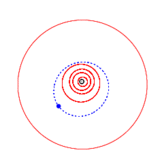9963 Sandage
|
Orbits of 9963 Sandage (blue), inner planets (red) and Jupiter (outermost) | |
| Discovery [1] | |
|---|---|
| Discovered by | E. F. Helin |
| Discovery site | Palomar Obs. |
| Discovery date | 9 January 1992 |
| Designations | |
| MPC designation | 9963 Sandage |
Named after |
Allan Sandage (astronomer)[2] |
|
1992 AN · 1976 NH 1989 CK6 | |
| main-belt · Phocaea [3] | |
| Orbital characteristics [1] | |
| Epoch 27 June 2015 (JD 2457200.5) | |
| Uncertainty parameter 0 | |
| Observation arc | 26.54 yr (9,692 days) |
| Aphelion | 2.9985 AU |
| Perihelion | 1.6831 AU |
| 2.3408 AU | |
| Eccentricity | 0.2809 |
| 3.58 yr (1,308 days) | |
| 272.37° | |
| Inclination | 23.462° |
| 116.97° | |
| 241.19° | |
| Earth MOID | 0.7726 AU |
| Physical characteristics | |
| Dimensions | 5.45 km (calculated)[3] |
|
4.65053±0.00013 h[4] 4.6502±0.0008 h[5] | |
| 0.23 (assumed)[3] | |
| S [3] | |
|
12.9[1] 13.53[3] | |
|
| |
9963 Sandage, provisional designation 1992 AN, is a stony asteroid from the inner regions of the asteroid belt, about 5.5 kilometers in diameter. It was discovered by American female astronomer Eleanor Helin at the U.S. Palomar Observatory in California on 9 January 1992.[6]
The stony S-type asteroid is a member of the Phocaea family, a group of asteroids with similar orbital characteristics. It orbits the Sun at a distance of 1.7–3.0 AU once every 3 years and 7 months (1,308 days). Its orbit shows an eccentricity of 0.28 and an inclination of 23 degrees from the plane of the ecliptic.[1]
In 2012 and 2015, two photometric light-curve analysis at the Palomar Transient Factory and at Texas Tech's Preston Gott Observatory rendered a well-defined rotation period of 4.65 hours with a high brightness amplitude of 0.56 and 0.43 in magnitude, respectively.[4][5] The Collaborative Asteroid Lightcurve Link assumes an albedo 0.23, which is a typical value for the surface of stony asteroids, and calculates a diameter of 5.45 kilometers based on an absolute magnitude of 13.53.[3]
The minor planet was named after American astronomer Allan Sandage (1926–2010), who worked at Palomar and Mount Wilson Observatory. He was an international authority in stellar astronomy and observational cosmology.[2] Sandage determined the first reasonably accurate values for the Hubble constant and also discovered the first quasar.
References
- 1 2 3 4 "JPL Small-Body Database Browser: 9963 Sandage (1992 AN)" (2015-08-19 last obs.). Jet Propulsion Laboratory. Retrieved January 2016.
- 1 2 Schmadel, Lutz D. (2007). Dictionary of Minor Planet Names – (9963) Sandage. Springer Berlin Heidelberg. p. 715. ISBN 978-3-540-00238-3. Retrieved January 2016.
- 1 2 3 4 5 6 "LCDB Data for (9963) Sandage". Asteroid Lightcurve Database (LCDB). Retrieved January 2016.
- 1 2 Clark, Maurice (January 2016). "Asteroid Photometry from the Preston Gott Observatory". Bulletin of the Minor Planets (Section of the Association of Lunar and Planetary Observers) 43 (1): 2–5. Bibcode:2016MPBu...43....2C. ISSN 1052-8091. Retrieved January 2016.
- 1 2 Waszczak, Adam; Chang, Chan-Kao; Ofek, Eran O.; Laher, Russ; Masci, Frank; Levitan, David; et al. (September 2015). "Asteroid Light Curves from the Palomar Transient Factory Survey: Rotation Periods and Phase Functions from Sparse Photometry". The Astronomical Journal 150 (3): 35. Bibcode:2015AJ....150...75W. doi:10.1088/0004-6256/150/3/75. Retrieved January 2016.
- ↑ "9963 Sandage (1992 AN)". Minor Planet Center. Retrieved January 2016.
External links
- Asteroid Lightcurve Database (LCDB), query form (info)
- Dictionary of Minor Planet Names, Google books
- Asteroids and comets rotation curves, CdR – Observatoire de Genève, Raoul Behrend
- Discovery Circumstances: Numbered Minor Planets (5001)-(10000) – Minor Planet Center
- 9963 Sandage at the JPL Small-Body Database
| ||||||
| ||||||||||||||||||||||||||||
